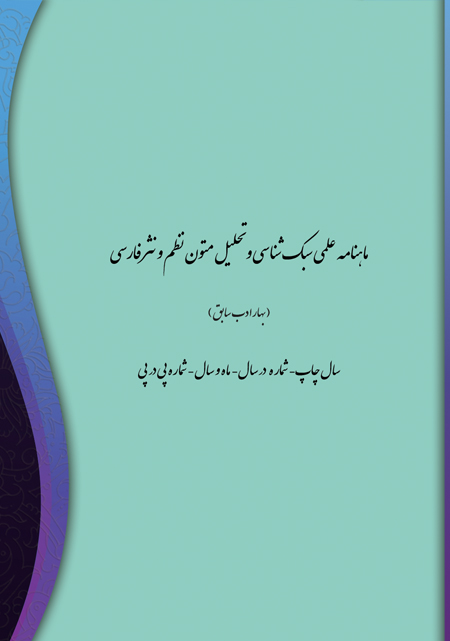- Count View : 7
- آدرس کوتاه شده مقاله: https://bahareadab.com/article_id/1876
- کد doi مقاله: Doi: 10.22034/bahareadab.2025 .18 .7910
Journal of the stylistic of Persian poem and prose
volume Number 18،
number In Volume 6،
،
issue Number 112
Thematic Analysis and Narrative Elements in the Book "Frequency 1160", by Fazlullah Saberi
Babak Roozbeh , Shahrokh Hekmat (Author in Charge), Mohsen Izadiar
Abstract
BACKGROUND AND OBJECTIVES: With the beginning of the Sacred Defense, the daily notes of the warriors, the narration of the events of the war in the reports of the journalists, transformed the memoirs of the Sacred Defense into a literary trend in the country. Gradually, these narratives were combined with literary techniques, artistic taste and the use of special characteristics to gradually form the dominant literary trend in the country"s literature. In this study, we have tried to introduce memoir writing as a type independent of other narratives by presenting our proposed elements.
METHODOLOGY: This research was conducted with a theoretical study using the library research method and the analysis method. The scope and population of the study is the book "Frequency 1160" by Fazlullah Saberi, published by Sureh Mehr Publishing.
FINDINGS: Memoirs are always examined with other literary genres such as stories, novels, biographies, travelogues, etc. and are not considered independent of other narratives. Memoir writing is a genre independent of other narratives that can be a platform for other literary and historical genres. The most important characteristic of memoirs is citation, which distinguishes it from other genres. The suggestions presented in this research were prepared by studying the existing sources in order to present complete elements and to be able to establish their place in the elements of memory.
CONCLUSION: In the work under study, the pivotal role of the element of time in the coherence of the narrative, direct and indirect characterization of the radio staff, first-person point of view, precise and documented location, use of spoken and standard prose, have added to the believability of the narrative. Also, the new subject, the issue of media resistance, and the presence of authentic documents are other important features of "Frequency 1160". By observing the proposed narrative elements, the author has been able to create a coherent, documented, and influential work that has an independent position from other literary genres in the field of sustainability literature and is also an independent work in its own right.
Keyword
Written memory
, narrative
, sacred defense
, subject
, elements
, frequency 1160
- Abbott, H. Porter (1987). Narrative Literacy. Translated by Roya Pourazar, Nima Ashrafi (2023). Tehran: Atraf Publications.
- Amid, Hassan (2009). Amid Literature. Thirty-sixth Edition. Tehran: Amir Kabir.
- Amirkhani, Masoud (2022). Memoir Writing in the Sacred Defense Ecosystem. Tehran: Sarir Publications.
- Arianpour Kashani, Manouchehr (2006). Arian's One-Volume Progressive Literature. Fourth Edition. Tehran: Jahan Rayane.
- Dad, Sima (1999). Dictionary of Literary Terms. Tehran: Morvarid Publications.
- Darakhshandeh, Abolfazl (2016). Advanced Memoir Writing Training. Tehran: Hadith Qalam Publications.
- Dehghan, Ahmad (2019). Soil and Memory. Tehran: Sarir Publications.
- Dehkhoda, Ali Akbar (2013). Dehkhoda Dictionary. Tehran: Tehran University Publications.
- Ebrahimi, Nader (1998). Writing Materials. First Edition. Tehran: Islamic Culture and Art Research Institute.
- Fattahi, Hossein (2007). Step-by-step story. Tehran: Sarir.
- Hari, Abolfazl (2012). Narrative Studies. Tehran: Liqaallah Publications.
- Kamri, Alireza (2015). Memorable essay. Tehran: Sarir.
- Khatibi, Hossein (1996). Prose Technique in Persian Literature. Tehran: Zavvar Publications.
- Maliki, Omid (2008). Sophisticated Persian Dictionary. Fifth edition. Tehran: Badihe.
- Mandanipour, Shahriar (2004). The Spirits of Shahrzad. Tehran: Qoqnoos.
- Mastour, Mostafa (2000). Basics of the short story. Tehran: Cheshme.
- Mirsadeghi, Jamal (2006). Elements of a story. Fifth edition. Tehran: Sokhan..
- Saberi, Fazllallah (2002). Frequency 1160. Third Edition. Tehran: Sooreh Mehr.
- Sangari, Mohammad Reza (2019). Holy Defense Literature. Tehran: Sarir.
- Sassani, Farhad (2008). Memory and War Discourse. Tehran: Sooreh Mehr Publications.
- Scholes, Robert (1968). Elements of Fiction. Translated by Farzaneh Taheri (1998). First Edition. Tehran: Markaz.
- Shamisa, Sirous (2007). Literary Types. Second Edition. Tehran: Mitra.
- Westland, Peter. Storywriting methods. Translated by Mohammad Hossein Abbaspour Tamijani (2008). First edition, Tehran: Mina.
- Younesi, Ebrahim (2005). The art of storywriting. Eighth edition. Tehran: Negah
- Articles
- Abdollahian, Hamid (2002). Story and Characterization in Stories. Journal of the Faculty of Literature and Humanities, University of Tehran.
- Farzad, Abdolhossein and Danesh, Kowsar and Khatami, Ahmad (2004). Analysis of the Key Works of the Holy Defense Fiction Literature from a Flowological Perspective. Year 17. Issue.
- Scientific Journal of Persian Poetry and Prose Stylistics (Former Bahar Adab). pp. 125-142
- Shamshirgarha, Mahboobeh (2018). Book Review: Memoir Writing and Its Place in the Historiography of the Qajar Era. Identifying the Types of Memoirs and Examining the Development of Memoir Writing in the Qajar Era, Focusing on the Impact of the Constitutional Revolution on This Phenomenon and Valuing the Place of This Movement in the Historiography of the Qajar Era. Year 8. Issue 1: Oral History Journal. 189-204.

